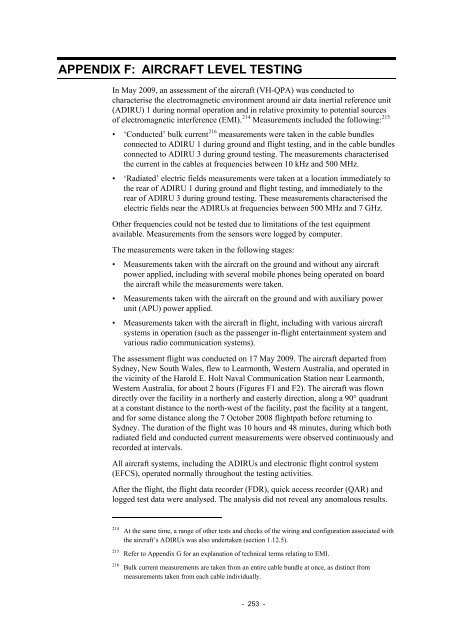In-flight upset - 154 km west of Learmonth, WA, 7 October 2008,
In-flight upset - 154 km west of Learmonth, WA, 7 October 2008,
In-flight upset - 154 km west of Learmonth, WA, 7 October 2008,
- No tags were found...
You also want an ePaper? Increase the reach of your titles
YUMPU automatically turns print PDFs into web optimized ePapers that Google loves.
APPENDIX F: AIRCRAFT LEVEL TESTING<strong>In</strong> May 2009, an assessment <strong>of</strong> the aircraft (VH-QPA) was conducted tocharacterise the electromagnetic environment around air data inertial reference unit(ADIRU) 1 during normal operation and in relative proximity to potential sources<strong>of</strong> electromagnetic interference (EMI). 214 Measurements included the following: 215• ‘Conducted’ bulk current 216 measurements were taken in the cable bundlesconnected to ADIRU 1 during ground and <strong>flight</strong> testing, and in the cable bundlesconnected to ADIRU 3 during ground testing. The measurements characterisedthe current in the cables at frequencies between 10 kHz and 500 MHz.• ‘Radiated’ electric fields measurements were taken at a location immediately tothe rear <strong>of</strong> ADIRU 1 during ground and <strong>flight</strong> testing, and immediately to therear <strong>of</strong> ADIRU 3 during ground testing. These measurements characterised theelectric fields near the ADIRUs at frequencies between 500 MHz and 7 GHz.Other frequencies could not be tested due to limitations <strong>of</strong> the test equipmentavailable. Measurements from the sensors were logged by computer.The measurements were taken in the following stages:• Measurements taken with the aircraft on the ground and without any aircraftpower applied, including with several mobile phones being operated on boardthe aircraft while the measurements were taken.• Measurements taken with the aircraft on the ground and with auxiliary powerunit (APU) power applied.• Measurements taken with the aircraft in <strong>flight</strong>, including with various aircraftsystems in operation (such as the passenger in-<strong>flight</strong> entertainment system andvarious radio communication systems).The assessment <strong>flight</strong> was conducted on 17 May 2009. The aircraft departed fromSydney, New South Wales, flew to <strong>Learmonth</strong>, Western Australia, and operated inthe vicinity <strong>of</strong> the Harold E. Holt Naval Communication Station near <strong>Learmonth</strong>,Western Australia, for about 2 hours (Figures F1 and F2). The aircraft was flowndirectly over the facility in a northerly and easterly direction, along a 90° quadrantat a constant distance to the north-<strong>west</strong> <strong>of</strong> the facility, past the facility at a tangent,and for some distance along the 7 <strong>October</strong> <strong>2008</strong> <strong>flight</strong>path before returning toSydney. The duration <strong>of</strong> the <strong>flight</strong> was 10 hours and 48 minutes, during which bothradiated field and conducted current measurements were observed continuously andrecorded at intervals.All aircraft systems, including the ADIRUs and electronic <strong>flight</strong> control system(EFCS), operated normally throughout the testing activities.After the <strong>flight</strong>, the <strong>flight</strong> data recorder (FDR), quick access recorder (QAR) andlogged test data were analysed. The analysis did not reveal any anomalous results.214215216At the same time, a range <strong>of</strong> other tests and checks <strong>of</strong> the wiring and configuration associated withthe aircraft’s ADIRUs was also undertaken (section 1.12.5).Refer to Appendix G for an explanation <strong>of</strong> technical terms relating to EMI.Bulk current measurements are taken from an entire cable bundle at once, as distinct frommeasurements taken from each cable individually.- 253 -



